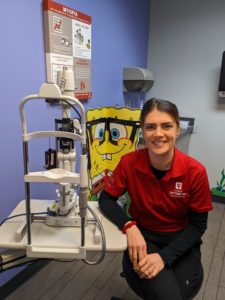
Dr. Connolly in an exam room in her clinic. She says that her clinic takes a conscientious and methodical approach to avoid coding mistakes.
By Katie Shulist Connolly, OD
Jan. 18, 2023
Slight mistakes in coding and billing can spell big trouble for your practice in lost reimbursements and the potential for the errors being spotted during costly insurance audits.
Correct coding goes hand-in-hand with correct charting. Quality medical charting is key to excellent patient care through communication to internal colleagues and external providers. It also is essential to providing accurate and detailed records to the patients who need them.
In my practice, we have a thorough system in place to review coding before claims are submitted, to prepare for coding changes and make adjustments as needed. Here are my top tips for implementing a similar systematic approach to coding in your practice.
Use Reliable Reference Points
Understand the American Medical Association (AMA)and Centers for Medicare and Medicaid Services (CMS) guidelines. These guidelines shape proper coding and billing practices and need to be followed by all providers.
Optimize Technology Support from EHR
Use built-in software systems within your electronic health record to get a basic idea for coding, but always double check these codes yourself and don’t rely on software systems solely. Be careful because many software systems haven’t updated their algorithm since the evaluation and management changes of 2021.
Review & Sign Off on Staff Coding Work
It is a common and acceptable practice for support staff to code on behalf of the doctor. However, it’s critical that the doctor review and sign off on the coding work of staff. Ultimately, the provider is responsible for the medical record, so they need to provide adequate training to staff and work closely with these individuals to maintain high-quality, accurate records.
Staff can be trained in-house to serve as scribes, taking down and entering patient information into their health records. The doctor should then review the record, make edits as appropriate and sign off. Some software systems are helpful as they allow a distinction between information recorded by a tech or scribe versus a provider.
OD Needs to Also Educate Themselves About Coding
For international classification of disease-10 (ICD-10), or diagnostic coding, online look-up tools such as icd10data.com, are comprehensive, free and easy-to-use websites that allow you to look up diagnostic codes.
AOA Focus, a magazine for American Optometric Association (AOA) members, is published every two months and always contains a column on coding and billing. I find these to be helpful snippets that usually address common challenges. The AOA also provides other resources on their website and have a panel of individuals called “AOA’s coding experts” that are available to members for advice.
Other Articles to Explore
Additionally, doctors can look in their state for continuing education programs. In my home state of Indiana, where I practice, every August there is the Annual Optometric Third Party Survival Course. This is a full day of education for both staff and doctors.
Make Denials a Learning Opportunity
Pay attention to processed claims, as this is how you can learn tips and tricks to avoiding denials in the future. Once a month, you can create a tutorial with support staff and the other doctors in your practice to pinpoint together what went wrong and discuss how to avoid the same mistakes going forward.
Get Outside Help from Consultancy
There are many companies that provide coding guidance for a consulting fee. This can be as simple as paying for an hour of their time to ask questions, or can be as involved as them auditing your practice to identify issues that could be caught in a true third-party audit.
Be Aware of Recent Changes to E/M Codes
In 2021, the system for Evaluation and Management (E/M) codes changed. This was the first substantial change to these codes since 1997. The system was changed to reduce documentation burden for providers and simplify audits. The previous system heavily emphasized history and examination elements while the new system focuses on medical decision-making. There are several subtle changes within medical decision-making compared to the 1997 guidelines, so all providers need to be thoroughly educated on these changes.
Click HERE to read tips from Mark Wright, OD, FCOVD, and Carole Burns, OD, FCOVD, on billing successfully under the new CMS E/M coding guidelines.
The AMA released the new guidelines, but it is important to remember that these guidelines are built for all of medicine. These broad guidelines then need to be applied to the detailed care we provide in the profession of optometry.
Over the last year and a half, coding experts have worked to understand these new guidelines and develop professional consensus. The first six months were difficult for all providers as we learned this new system together. There is now more consensus on interpretation of the guidelines, so it is important that providers continue to stay in touch with their peers and coding experts to ensure they understand.
Read Through Updated Guidelines with Your Partners & Staff
In my practice, we read through all the guidance provided by the AMA and had a small committee of people with various backgrounds (certified coder, certified biller, office manager, providers) review the guidelines together and create easy-to-digest materials for our doctors. We sought external consultation from a variety of sources to better understand the new guidelines.
We employ a certified coder who audits many of our records per week to provide doctors with personalized feedback. We have a quality-assurance program in place where providers review a sampling of each other’s charts to ensure both charting accuracy and quality of care. We also provide in-person group training for our providers led by our director of clinics.
With the right process, you can sharply reduce the risk of coding errors, lost reimbursement from claim denials and the possibility of an audit.
 Katie Shulist Connolly, OD, practices at Atwater Eye Care Center, the clinic of Indiana University School of Optometry. She has lectured at optometric meetings in recent years about best practices in patient charting and coding and billing. To contact her: ksconnol@indiana.edu
Katie Shulist Connolly, OD, practices at Atwater Eye Care Center, the clinic of Indiana University School of Optometry. She has lectured at optometric meetings in recent years about best practices in patient charting and coding and billing. To contact her: ksconnol@indiana.edu

























